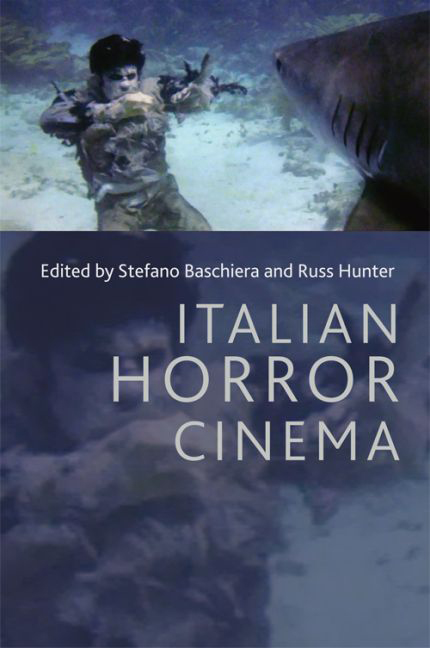Book contents
- Frontmatter
- Contents
- List of figures
- List of contributors
- Acknowledgements
- Introduction
- 1 Preferisco l'inferno: early Italian horror cinema
- 2 Domestic films made for export: modes of production of the 1960s Italian horror film
- 3 The 1980s Italian horror cinema of imitation: the good, the ugly and the sequel
- 4 Knowing the unknown beyond: ‘Italianate’ and ‘Italian’ horror cinema in the twenty-first century
- 5 Bavaesque: the making of Mario Bava as Italian horror auteur
- 6 The Argento Syndrome: aesthetics of horror
- 7 Scrap metal, stains, clogged drains: Argento's refuse and its refusals
- 8 The giallo /slasher landscape: Ecologia del delitto, Friday the 13th and subtractive spectatorship
- 9 Kings of terror, geniuses of crime: giallo cinema and fumetti neri
- 10 Political memory in the Italian hinterland: locating the ‘rural giallo’
- 11 The horror of progressive rock: Goblin and horror soundtracks
- 12 ‘The only monsters here are the filmmakers’: animal cruelty and death in Italian cannibal films
- 13 Italian horror cinema and Italian film journals of the 1970s
- Index
3 - The 1980s Italian horror cinema of imitation: the good, the ugly and the sequel
Published online by Cambridge University Press: 12 September 2017
- Frontmatter
- Contents
- List of figures
- List of contributors
- Acknowledgements
- Introduction
- 1 Preferisco l'inferno: early Italian horror cinema
- 2 Domestic films made for export: modes of production of the 1960s Italian horror film
- 3 The 1980s Italian horror cinema of imitation: the good, the ugly and the sequel
- 4 Knowing the unknown beyond: ‘Italianate’ and ‘Italian’ horror cinema in the twenty-first century
- 5 Bavaesque: the making of Mario Bava as Italian horror auteur
- 6 The Argento Syndrome: aesthetics of horror
- 7 Scrap metal, stains, clogged drains: Argento's refuse and its refusals
- 8 The giallo /slasher landscape: Ecologia del delitto, Friday the 13th and subtractive spectatorship
- 9 Kings of terror, geniuses of crime: giallo cinema and fumetti neri
- 10 Political memory in the Italian hinterland: locating the ‘rural giallo’
- 11 The horror of progressive rock: Goblin and horror soundtracks
- 12 ‘The only monsters here are the filmmakers’: animal cruelty and death in Italian cannibal films
- 13 Italian horror cinema and Italian film journals of the 1970s
- Index
Summary
ITALIAN HORROR AND THE 1980S CRISIS
In the first half of the 1980s, Italian horror cinema thrived amid a significant moment of crisis and structural changes in the national film industry and infrastructure. During the decade, the crisis of Italian cinema, which began in the 1970s, worsened significantly and affected all sectors of the industry. Specifically, the exhibition sector continued to struggle and witnessed an apparently irreversible resizing of the number of cinema theatres in the country and a massive decline in the number of the increasingly expensive tickets sold (Corsi, 2001: 116–23). The second- and third-run theatres – in particular, the provincial ones – which constituted the backbone of Italian cinema-going faced the crisis of the sector first, soon followed by more prestigious urban exhibition centres.
The national film industry was adapting to and attempting to rationalise the uncontrolled emergence of private television networks. In fact, they were not only the main competitors of theatrical exhibition but, as I shall discuss later, they became the key players in national film production. The first consequence was a consistent withdrawal to the national signalled by the gradual departure from the international stage that Italian cinema was accustomed to, as well as the more limited ability to attract foreign investments and to participate in ambitious European co-productions (Corsi, 2001: 139–41).
While art cinema struggled with the challenges of a generational renewal and a generalised lack of ambition of producers, a creative crisis also hit the last haven of Italian cinema: its genre production. The inevitable move of popular cinema from third-run theatres to the small screen began to impact the quantity and quality of the films produced.
Arguably, the crisis did not impact horror cinema. In truth, the production of horror films quantitatively thrived during the late 1970s and early 1980s. As Paolo Russo points out, between 1977 and 1985 seventy-five films belonging to the horror genre were produced, with seventeen films made in the years 1977 to 1980, ‘for an average percentage close to the six per cent (of the entire production) a figure which is undoubtedly relevant in particular if compared with the numbers of the previous decades’ (Russo, 2005: 441).
- Type
- Chapter
- Information
- Italian Horror Cinema , pp. 45 - 61Publisher: Edinburgh University PressPrint publication year: 2016

